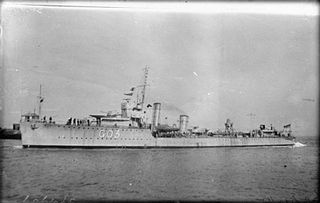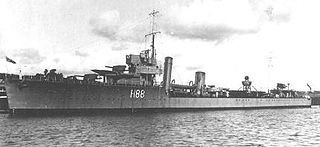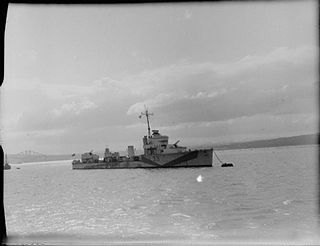
Novík was a destroyer of the Russian Imperial Navy and Soviet Navy, commissioned in 1913 where she served with the Baltic Fleet during World War I. She joined the Bolsheviks in November 1917 and was renamed Yakov Sverdlov in 1923. She was a training ship when Operation Barbarossa began, but was recalled to active duty the following day. She struck a mine on 28 August 1941 and sank while escorting an evacuation convoy during the Soviet evacuation of Tallinn.
The Ariete-class torpedo boats were a group of destroyer escorts built for the Italian Navy during World War II. They were enlarged versions of the Spica-class torpedo boats and designed to escort convoys to North Africa. Of the 42 units planned, sixteen ships were eventually ordered but only one was completed by the time of the armistice, Ariete, built in the Sestri Ponente shipyards and commissioned on 5 August 1943. The namesake ship was also the only one to survive the war. After the war it was ceded to the Yugoslav Navy (1949), and renamed Durmitor.

HMS Vortigern was a V-class destroyer of the Royal Navy. She served in both World Wars, and was sunk in 1942.

HMS Wakeful was a W-class destroyer of the Royal Navy, built under the 1916–1917 Programme in the 10th Destroyer order. Wakeful was assigned to the Grand Fleet after completion, and served into the early years of the Second World War. Wakeful was torpedoed and sunk during Operation Dynamo by a German E-Boat on 29 May 1940.

The German torpedo boat T36 was the last of 15 Type 39 torpedo boats built for the Kriegsmarine during World War II. Completed in late 1944, T36 was assigned to convoy escort duties and supporting German forces in the Baltic. At the end of January 1945, she rescued survivors from the torpedoed ocean liner MV Wilhelm Gustloff. The boat screened German warships as they bombarded advancing Soviet troops and escorted convoys over the next several months. In May, T36 began to ferry refugees; she struck a mine on 4 May and was sunk by Soviet aircraft the following day.

HMS Vivacious (D36) was a V-class destroyer of the British Royal Navy that saw service in World War I and World War II.

The second HMS Vega was a V-class destroyer of the British Royal Navy that saw service in World War I and World War II.

HMS Vivien (L33) was a V-class destroyer of the British Royal Navy that saw service in World War I and World War II.

The third HMS Windsor (D42) was a W-class destroyer of the British Royal Navy that saw service in the final months of World War I and in World War II.

HMS Viceroy (D91) was a W-class destroyer of the British Royal Navy that saw service in the final months of World War I and in World War II.

The French destroyer Aigle was the lead ship of her class of destroyers (contre-torpilleurs) built for the French Navy during the 1920s.

The German torpedo boat T2 was one of a dozen Type 35 torpedo boats built for the Kriegsmarine during the late 1930s. Completed in 1939, she was not combat ready until mid-1940, when she spent several months escorting minelayers as they laid minefields. The boat returned to Germany after being damaged and supported operations in the Baltic Sea after the start of Operation Barbarossa in June 1941. T2 returned to France at the end of the year, escorting a commerce raider through the English Channel. She then escorted a pair of battleships and a heavy cruiser through the Channel back to Germany in early 1942 in the Channel Dash. The boat was placed in reserve upon her return and was transferred back to France in 1943, where she helped to escort blockade runners through the Bay of Biscay. In mid-1943, she returned to the Baltic and briefly served as flagship of a submarine flotilla before being assigned to the Torpedo School. T2 was sunk in an air raid in July 1944, but was refloated several months later. She was never repaired and eventually scrapped in 1946.

The German torpedo boat T7 was one of a dozen Type 35 torpedo boats built for the Kriegsmarine during the late 1930s. Completed in 1939, she was not combat ready until mid-1940 when she spent several months escorting minelayers as they laid minefields in the North Sea and the English Channel. The boat participated in an abortive attempt to attack several convoys off the Scottish coast in November. T7 returned to Germany for a refit in January 1941 and then supported operations in the Baltic Sea after the start of Operation Barbarossa in June. The boat was one of the escorts for several commerce raiders passing through the English Channel in late 1941 and then escorted German ships in Norwegian waters in mid-1942. She was briefly placed in reserve later that year and was then reactivated for service with the Torpedo School. T7 was sunk in an air raid in July 1944, but was refloated several months later. She was never repaired and was scrapped in 1947–1949.

The German torpedo boat T8 was one of a dozen Type 35 torpedo boats built for the Kriegsmarine during the late 1930s. Completed in 1939, she was not combat ready until mid-1940 when she spent several months escorting minelayers as they laid minefields in the North Sea and the English Channel. The boat participated in an abortive attempt to attack several convoys off the Scottish coast in November. T8 returned to Germany for a refit in January 1941 and then supported operations in the Baltic Sea after the start of Operation Barbarossa in June. She was briefly placed in reserve at the end of the year and was then reactivated for service with the Torpedo School. In February 1944 the boat returned to active duty and was assigned to the Baltic Sea area where she supported German operations. T8 escorted a bombardment mission in February 1945 and was sunk by British aircraft on 3 May.

The German torpedo boat T9 was one of a dozen Type 35 torpedo boats built for the Kriegsmarine during the late 1930s. Completed in July 1940, the boat participated in an abortive attempt to attack several convoys off the Scottish coast in November. T9 was placed in reserve in August 1941 and was reactivated in June 1942 for duties in France. She participated in an unsuccessful attempt to escort a blockade runner through the Bay of Biscay in early 1943 and was then transferred to the Torpedo School in September. In mid-1944 the boat returned to active duty and was assigned to the Baltic Sea area. She escorted a bombardment mission in November and was damaged by bombers in East Prussia in early 1945. T9 was sunk near Kiel, Germany, during an air raid on 3 May.

The German torpedo boat T11 was one of a dozen Type 35 torpedo boats built for the Kriegsmarine during the late 1930s. Completed in mid-1940, the boat was deployed in the English Channel later that year and returned to Germany in December. She then supported operations in the Baltic Sea after the start of Operation Barbarossa in June. T11 was transferred to France at the end of the year and helped to escort a pair of battleships and a heavy cruiser through the Channel back to Germany in the Channel Dash in early 1942. She then escorted German ships in Norwegian waters for several months and was placed in reserve when she returned to Germany. The boat spent all of 1943 and 1944 either refitting or assigned to the Torpedo School. T11 returned to active duty at the beginning of 1945 and survived the war. The boat was allocated to the British after the war, but she was transferred to France in 1946. Unused by the French Navy, she was stricken from the Navy List in 1951 and subsequently scrapped.

The German torpedo boat T13 was the lead ship of her class of nine torpedo boats built for the Kriegsmarine during the late 1930s. Completed in mid-1941, the boat was assigned convoy escort work in the Baltic Sea before she was transferred to Occupied France in early 1942. T13 helped to escort a pair of battleships and a heavy cruiser through the English Channel back to Germany in February in the Channel Dash and then returned to France in July after receiving a refit. There the boat laid minefields and escorted Axis blockade runners through the Bay of Biscay into the Atlantic Ocean. In mid-1943, she was assigned to the Torpedo School where she remained until mid-1944. T13 returned to the Baltic where she screened German ships as they bombarded Soviet positions for the rest of the year. The boat was then assigned convoy escort duties in the Skagerrak around the beginning of 1945. During one such mission in April, T13 was sunk by Royal Air Force (RAF) bombers.

The German torpedo boat T18 was one of nine Type 37 torpedo boats built for the Kriegsmarine during World War II. Completed in mid-1941, she was later assigned to the Baltic Sea for convoy escort duties. The boat briefly became a training ship in 1942 before she was transferred to France where she laid minefields and escorted Axis blockade runners and U-boats through the Bay of Biscay into the Atlantic Ocean. T18 returned to Germany in mid-1943 and became a training ship again for the Torpedo School and U-boat Flotillas. The boat returned to active duty in mid-1944 and assigned to the Baltic where she was sunk by Soviet aircraft in September.

The German torpedo boat T33 was one of fifteen Type 39 torpedo boats built for the Kriegsmarine during World War II. Completed in mid-1944, the boat was assigned to convoy escort duties and supporting German forces in the Baltic. She escorted a heavy cruiser in January 1945 as she bombarded Soviet troops and helped to evacuate troops and refugees from advancing Soviet forces in May. T33 was allocated to the Soviet Union after the war and was renamed Primerny. She served with the Baltic Fleet until 1954 when the ship was converted into an accommodation ship and renamed PKZ-63. She was turned over to be scrapped on 9 November 1956 and subsequently broken up.

The German torpedo boat T31 was one of fifteen Type 39 torpedo boats built for the Kriegsmarine during World War II. Completed in early 1944, the boat was assigned to convoy escort duties and supporting German forces in the Baltic. She was sunk in combat with Soviet motor torpedo boats on 20 June off the Finnish coast on 20 June with 82 men killed.













